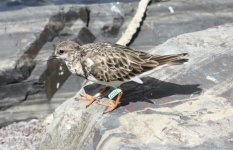Cruise part one - US Virgin Islands
I'm just a little bit behind on these reports. I'll try to catch up. Here are the first two days of the cruise itself, in the US Virgin Islands.
St. John’s – December 12, 2010
Our cruise’s first port of call was the island of St. Thomas, of the U.S. Virgin Islands. But we pretty much skipped it, and took the ferry to the neighboring St. John’s. St. John’s is relatively undeveloped since the majority of the island is protected in the Virgin Islands National Park. The plan was to do some snorkeling along the coral reefs, with just a little birding.
You can do a good bit here without a car, but since there were some out of the way places I wanted to go and we were on a strict schedule, we rented a car for the day. The only cars available are four wheel drive Jeeps. After just a few minutes of driving I could see why. These were the steepest, craziest roads I had ever driven. I think a 4×4 high clearance vehicle was necessary to make it up some of the hills!
The first stop was the Cinnamon Bay loop trail for a token shot at Bridled Quail-dove. This is a short loop through the forest. It’s probably not the best place on the island for the dove, but it was the most convenient for us. It was not very birdy at all; I only recorded a couple
Pearly-eyed Thrashers and
Bananaquits.
The rest of the day was spent driving around exploring the island and some snorkeling at world-famous Trunk Bay, considered one of the world’s most beautiful beaches. The snorkeling was fine, given the number of people around. There were a good many fish, and some coral. But it was a good thing we did this first, as it paled in comparison to the snorkeling later in the trip. The highlight for me was my lifer of the day –
Brown Booby. Three of them were perched on the rocks above the snorkeling area.
The only other birds seen on St. John’s were
Brown Pelican,
Red-tailed Hawk,
Zenaida Dove,
Common Ground-dove, and
Gray Kingbird.
St. Croix – December 13, 2010
Day two saw us in St. Croix, the largest of the U.S. Virgin Islands. The plan was much the same as the day before – snorkeling and a little exploring and shopping in town. Any birding would be incidental.
About a month before our trip, I had booked a trip to Buck Island Reef National Monument (direct with Big Beard’s). We took a boat to the pristine offshore island where we snorkeled among a much larger and diverse coral reef. There were a few birds around, such as an
Osprey,
Brown Boobies, and several
Magnificent Frigatebirds. While frigatebirds are very common in the Caribbean, I don’t think I could ever get tired of seeing them overhead. But the most exciting views were decidedly aquatic rather than aerial. I didn’t see any hoped-for sea turtles, but a sting ray, several Barracuda, and many kinds of coral were ample compensation.
We had lunch along the water’s edge in Christiansted.
Rock Pigeons and
House Sparrows were expected, but a small group of
Ruddy Turnstones foraging near the tables was not. One of them was even banded. From what I could find online, the light green flag means that it was banded in Suriname. I reported the sighting, but haven’t heard anything back yet on the origin of the bird.
I got my lifer-of-the-day at the cruise ship pier at nearly the last minute. A hummingbird put in a brief appearance. From what I could see, along with the location, it had to be a
Green-throated Carib.
Also at the pier I recorded both
Caspian and
Royal Terns. While Royal is to be expected, it seems that Caspian is regarded as a vagrant outside the Greater Antilles and Barbados. I remember the purported Caspians flying right overhead, and I didn’t have much doubt about them. But I’d be grateful if anyone knows the current status of any Caspians in the Virgin Islands.
Overall, it was a very pleasant two days. Not much in the way of birds, but some great snorkeling and I got to add several ticks to my national parks, not to mention bird, life list.
The turnstone was the only decent bird picture I got, but there are a couple scenery shots on
my blog post.






